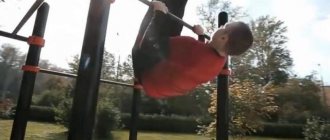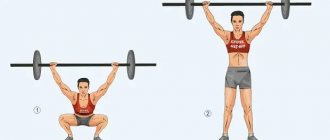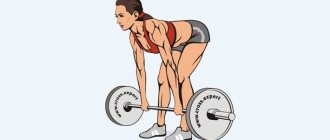Box jumps have long gained popularity in both weightlifting and CrossFit. Including this exercise in your training program aims to develop explosive leg strength. For this reason, I consider it advisable to use it in kettlebell lifting. Exercise increases the overall endurance of the athlete, maximum oxygen consumption (VO2 max), improves coordination and flexibility, which is also important. In addition, box jumps train the nervous system, forcing the leg muscles to contract as quickly as possible in a minimum period of time.
When performing jumping jacks, almost all the muscles of the body are involved in the work. In this case, the most actively involved are:
- quadriceps;
- hamstrings;
- calf muscles;
The muscles of the back and abdominals also take part in the work, and tendons are worked out.
When performing the exercise, you must be as focused as possible, as it requires high concentration. The height of the cabinet should be adjusted based on the current level of physical and technical fitness. In any case, you need to start from a low height.
Jumping onto a pedestal technique
- Stand in front of the cabinet at a distance of 0.5 to 1 m. Feet shoulder-width apart. This is the starting position.
- To jump, sit down and swing your arms back.
- When jumping onto a box, lift your knees and hips as high as possible. In this case, the arms move forward and upward.
- You must land on both feet. Knees slightly bent. You can jump with two legs or one at a time.
Execution Rules
Random and irregular jumping are signs of poor technique. So remember:
- You should land on your full foot and not put your weight on your toe or heel.
- Your knees should be in a neutral position. They don't need to be folded.
- The abdominal muscles are tense. Try not to round your spine.
- When you reach the highest point of the jump, stop and secure your position. This will reduce the risk of injury.
- If you are jumping more than 50 centimeters high, place a smaller box next to it. This way you can get off safely. This will take the stress off the tendons and completely prevent unnecessary injuries.
How to do steps for beginners
For beginners, these exercises are suitable, but with some caveats - for example, they should perform step-ups without weights. “Standing on one leg is not easy, but performing an extension movement while lifting your own body weight is even more difficult,” says Nikita Kusakin. - Therefore, it is best to master this exercise without using additional weight. The height of the platform also plays an important role. The higher it is, the more difficult it is to perform the exercise.”
The optimal height of a pedestal or platform is 20-40 cm. If you feel that when you take steps, you want to push off the floor harder, perhaps the height of the platform is not suitable for you.
What exercises can be performed based on stepping onto a pedestal? We asked Alexey Bolyaev to show us variations of these movements.
Useful tips
Box jumps are a great tool to help you improve your performance, but any training tool that is used haphazardly can cause harm rather than positive athletic results.
When beginners start using this exercise to improve their overall fitness, their landing technique often suffers, which in turn can lead to leg damage (when the foot pronates), and the constant landing with the knees in an x-shape will eventually end detrimental to them.
Doing jumping jacks in a high-repetition style at a fast pace will not allow the hip joint to fully expand, which is not a good thing. Without full hip extension, it is impossible to jump high, sprint, perform good squats, or fully extend in a deadlift.
Use box jumps where they belong - before training, as an exercise for explosive strength. And to improve your overall fitness, it is better to jump rope.
Important: Don't do box jumps if you rarely go to the gym. And you spend most of your time sitting at the computer
Common mistakes
Now let's look at the typical mistakes made by CrossFit athletes when performing box jumps:
- Incorrect position of the spine. It often occurs if the gaze is not directed forward in front of you, but down at the cabinet. At the same time, the back is rounded, which leads to impaired technique and possible injuries.
- Inappropriate use of hands when jumping. You need to make a strong and clear swing with your hands. This will allow you to increase the power of your jump by up to 40%.
- Improper landing and knee position can lead to ankle and knee injuries. You should land softly on slightly bent legs and immediately jump from this position in one movement.
- Pausing after landing on the floor simply wastes your energy. It follows that rest between jumps must be done on a stand.
Recipes for healthy eating
Oatmeal pancake - the simplest diet pancake recipe
- 4.37 Proteins
- 10.7 Fats
- 28.2 Carbohydrates
- 256 kcal
20-25 min.
- #dietary
- #breakfast
- #milk
- #low calorie
- #cereals
- #vegetable oil
- #egg
Other recipes
What workouts should you prefer to improve your vertical jump?
Beginning athletes can be advised to focus on strength training. You should work with heavy weights (80-90% of the maximum) and perform the exercise for 4-6 repetitions with sufficient rest between approaches. This way you will develop much-needed strength. You don’t need to start the exercise with a lot of weight right away; do 2 or even three warm-up approaches with a gradual increase in weight before you reach the “working” weight. The following exercises are suitable for strength training:
- squats
- leg press in the machine
- weighted lunges
- calf raises
- barbell squats (emphasis is on slowly lowering and getting up explosively)
Also, don’t forget about the muscles of the abs, chest, and back. We include in the training such exercises as deadlifts, barbell presses, work on a vertical and horizontal block, pull-ups, push-ups and parallel bars.
As your strength increases, dynamic training should be included in your training process. Large weights help increase strength, but at a certain stage this will not be enough for a jump. After all, the main component of a vertical jump is explosive power, that is, a combination of strength and speed. And CrossFit is ideal for such dynamic workouts. Include the following exercises in CrossFit complexes:
- front squats
- lunges
- jumping on the cabinet
- jumping with a bar from a squat
- burpees
- throwing the ball at a target
- thrusters, etc.
But these exercises should already be performed intensively, and the weight of the weights will accordingly be significantly less (about 30% of the maximum). In CrossFit, you will perform exercises for time or as many as you can within a certain amount of time. That is, in all cases you will have to work intensively, which contributes to the development of explosive power.
The advantage of such training is that you simultaneously work on speed, strength, coordination and endurance. And this will have a positive impact not only on your jump, but also on your game as a whole.
Here are several complexes for developing jumping ability.
Lower body exercises
With the help of such an elementary cabinet you can perfectly work out the lower body. Here are some exercises you can add to your program:
- Projections on the cabinet
.
Despite its simplicity in appearance, this is a very difficult exercise. Not only will you need a lot of stamina to climb up, but you can also take extra weight (dumbbells) with you. Here each leg is worked out separately, which is also a plus. The target muscles are the buttock, hamstrings and a little quadriceps
(but with the right technique it is included quite a bit). - Bulgarian lunge.
This is perhaps the most difficult lunge variation.
Its essence is that the back leg is placed on an elevation (in this case, boxing), which is why almost the entire body weight goes to the front leg
(in particular, to the buttocks).
- Jumping on a stand
. This kind of “avant-gardeism” came to the gym from CrossFit: it was here that they began to jump onto elevated surfaces, trying to “kill themselves” as much as possible on the workout. The exercise is difficult, good, but requires healthy knees and back. Plus, you definitely need to keep an eye on your equipment! - Squats.
More specifically, correct squats with maximum abduction of the pelvis back. The stand is perfect for helping beginners who are just learning how to squat. Yes, and experienced athletes will also be interested in working out the gluteal muscles in this version with little weight (or without it at all), so to speak, “by feel.”
Plyometrics
Plyometrics includes specific exercises to activate quick response and develop the elastic properties of the core muscles.
The biomechanical basis of plyometric action is still being studied. Muscles contain elastic components that are activated in series or in parallel, with a contractile component. We are talking about a lengthening-shortening cycle, in which lengthening of a muscle beyond its resting length is accompanied by active contraction. Tendons and crossbars are capable of storing energy through elongation. If the first phase occurs in a short time, this energy is added to the energy created by the contraction. The overall strength is higher than that of a stimulated muscle without prior stretching. This type of exercise is used in techniques and training that require explosive striking movements such as jumping, for example.
Plyometrics was originally practiced by Soviet Olympians and then began to be used throughout the sports world.
Sports using plyometrics: basketball, squash, tennis, badminton, volleyball, football, as well as various types of fitness and parkour.
Most athletes perform simple and complex jumps and call them plyometrics, not jumping impact training, as it was called and recommended in the past by the founder of plyometrics, coach Verkhoshansky. This form of jumping training is still very popular today. And plyometrics has become a buzzword for many types of movements. The use of the term has spread so much that push-ups are now even called plyometric.
The term plyometric is a combination of Greek roots that mean “increase in size” (plyo means “more”, metric means “length”).
Exercises for high jumps and more
We must pay tribute to the special programs designed to increase the jump.
Some suggest performing various exercises without taking into account the individual characteristics of the player, the basketball schedule, as well as the current height of the jump. Below are several exercises that contain useful information on what to do to jump higher. Firstly, before any workout you need to thoroughly warm up your muscles, so to speak, set them up for effective work. Calf raises are great. The plus is that it can be performed in completely different ways: on a wall bars in the hall or on the stairs. The most important thing to observe is lifting the body using the calf muscles. Approaches can be alternated: on the right leg, on the left and on both. One approach per leg will be enough (20 repetitions per approach).
So, we found out that jumping is one of the main components of the individual skill of each player. To increase it, you need to pump up all the muscles involved, but each one separately. During training, practice types of jumps. Some programs are not designed exactly as needed, so they need to be adapted to your own training regimen, taking into account all the nuances.
Upper body exercises
In addition, you can use boxing to work on the top. No, no, no one is telling you to lift it up and do a shwung to the top! ?But for reverse push-ups
she'll do just fine. Place your hands on the box, place your feet on the floor or on a raised platform - and let's go!
You can also work out the core. You can make a regular plank more challenging by placing your feet on the box.
, not on the floor. An even more complicated option is to add the “climber” exercise here (bend your legs to your chest one by one).
A wooden box that is lying around in the corner of your gym can be a great helper in your training! So experiment and surprise your muscles! Good luck!
Anita, your online trainer MORE
How to make exercises more difficult
The easiest way to do this is to add additional weights. “When we hold, for example, dumbbells in our hands, lowered along the body, the load is directed along the axis of the body, thereby evenly loading the quadriceps and gluteal muscles,” explains Nikita Kusakin. - If you take dumbbells and place them in front of you on bent arms, then the load will shift to the quadriceps muscle. Now the weight will pull us forward, and to make it easier to hold it, we will have to straighten our body as much as possible. This will shift the load from the buttocks to the hips in percentage terms.”
Use this little trick if you want to change the level of load on different areas of the thighs and buttocks.
And don't forget to balance the load. “If you try to constantly increase the working weight, then there is a high probability of getting a knee joint injury,” warns Nikita Kusakin.
Follow these rules to exercise healthily.
Increased activity of the central nervous system
If you don't include explosive and speed exercises in your training program, then don't be surprised if the weights on the bar stop growing. By performing box jumps, you first of all strengthen the central nervous system, which will allow it to work better and more efficiently during training.
And by increasing the efficiency of the nervous system, you will improve explosive strength, which, in turn, will allow you to work longer and longer with submaximal weights and, as a result, build muscle mass.
High jump and factors for its improvement
First you need to understand what a jump is. This is a vertical body impulse created by a certain sequence of different muscle groups. That is, in order to increase the height of the jump, you need to work these muscles. Parts of the body such as the back, legs, and hips are involved in the jump.
That is, deciding to learn to jump higher. What you need to develop is explosive power. And if you decide to take this issue seriously, first of all follow the following rules:
- visit the gym regularly, but if you do not have such an opportunity, work out at home. The main thing here is not to miss training, that is, perseverance and consistency;
- eat right, your diet should be balanced, consisting of healthy foods to the maximum;
- keep drinking regime;
- get enough sleep, lack of sleep leads to lethargy, loss of strength and reluctance to perform physical activity;
- record the initial height of the jump, and then regularly record changes, if any. Based on this data, you will be able to evaluate the effectiveness of the selected exercises and, if necessary, revise them and replace them with others when the results are not noticeable;
- Never forget to warm up before training; the muscles should be warmed up and prepared for stress, thereby minimizing the risk of injury. Warm-up should take from ten to twenty minutes;
- be sure to include stretching exercises in the warm-up before the main ones;
- do not skip workouts, the optimal number is three to four per week;
- do not expect instant results, you will be able to see changes in about a month if you follow all the recommendations.
Plyoboxes – what are they, what are they for?
The plyobox is a durable, stable box designed for plyometric exercises. Jumping is usually the most common exercise performed with them. But this is not the only way to use it. Steps, push-ups, squats, lunges and other movements are also common. How exactly to use this type of machine depends on the sport being practiced.
Plyometric training is used by athletes to improve athletic performance. However, this does not mean that you have to be an athlete to perform these exercises. Plyometrics are great for those who are bored with traditional training or like simple movements. Plyo boxes will complement any gym, home or professional, because they are extremely versatile.
Read also: Phytic acid in food
The Dangers of Plyometric Exercises
I once wrote about injuries, p.
There was mention of shin splints. And one of the reasons for this problem is the lack of readiness of a specific muscle group for a specific load. What I mean by this is that running is also a plyometric exercise, where the entire lower part of the body is primarily involved. This injury is far from the only one. Many injure the ankle and lower parts of the foot. This most often happens to unprepared people who decide to start running, jumping rope or steppe, and so on. The muscles are simply not ready for contractions and stretches; they are like candied honey that needs to be melted to give it a liquid and elastic form. In addition, the problem with such injuries arises in the light of the lack of high-quality warm-up, as well as incorrectly selected sports shoes.
It is for this reason that I personally am often skeptical about the same step aerobics (which can also be performed at different rhythms), which involves the presence of plyometric load, and the training takes place in a group mode, where one part of the audience can be well prepared, while the other remains in the risk zone.
So, plyometrics exercises can be used by people with a certain physical readiness. For others, this will not only be traumatic, but also ineffective. But we will, perhaps inevitably, return to mentioning this point more than once during the course of the article.
Boxing everyone!
The presence of a wooden box in the gym often confuses people. Oh, how many questions and ideas you can hear about its use (from the stand to the seat)! Nevertheless, this tool can be used effectively in your training process.
Typically, such cabinets have different parameters: one side, for example, is half a meter, the other is 60 centimeters, and so on. This makes it possible to change the height of the box, simplifying or complicating the exercise.
Making a cabinet with your own hands
If you plan to carry out active training, then the CrossFit stand will help you a lot with this. This is a box that is used not only for performing the exercise - jumping, but also for squats and stretching the legs.
What you will need
In order to assemble such a cabinet you need to prepare the following materials and tools:
- plywood sheet;
- pencil or marker;
- jigsaw;
- special glue;
- grinder.
A do-it-yourself CrossFit cabinet is quite easy to assemble if you have even the slightest skills in performing such actions.
REFERENCE. Choose a thicker sheet of plywood and it is advisable that it be made of birch.
Soft landings
Box jumps are the most common type of jump in training programs for a reason - they reduce stress on your joints, calmly allow you to learn explosive power and land correctly and safely.
If we compare the landing phase of high jumps, long jumps and box jumps, box jumps place much less compressive stress on the knee joint.
This way, by performing box jumps, you can develop explosive power while avoiding damage to your knee joints. Box jumps, compared to other jumping options, can be trained quite often, since they do not have too powerful an effect on the entire body.
Creating a box jump program
First, if you feel pain while doing an exercise, don't do it. If you can't box jump correctly, start low. If an exercise doesn't meet your training goals, it's best to leave it.
The gentle nature of box jumps (when performed correctly) is great for strength training practitioners. For them, box jumps are a great tool for increasing athleticism and explosiveness without the same risk of injury as the high jump.
Box jumps are an explosive exercise and should be performed immediately before resistance training, but after warming up. Start performing 2-3 sets of 3-5 repetitions of static box jumps (we jump onto the box according to all the rules, but come down from it carefully, without jumping).
Remember: large volume is not important. High performance is important. Two to four sets of 3 to 5 reps is what most people need.
Recommendations for implementation in training
- Jumping can be integrated into any workout or performed as a separate element.
- Progression is carried out by increasing the number of jumps in the series, as well as increasing the height of the platform.
- Single jumps are used to maximize strength development. With this technique, the deepest squat is used in the starting position.
- In jumping series, you can perform sets by number of repetitions or time.
- It is strictly not recommended to use additional weights (weights, vests, etc.) to increase the load. This will lead to a significant increase in the compression load on the spine and joints.
Top best crossfit box models
- Yousteel. The brand offers wooden bollards for jumping from 50 to 75 cm. All products are reinforced with a special crosspiece in the center for strength. Material – FSF plywood 15 mm thick. The product arrives in disassembled form, which will not be difficult to fold.
- SPR Plyobox. The company offers plyoboxes in three sizes, allowing you to change the height and select the required size for each exercise. These designs are also convenient to use for push-ups, jumping jacks, walking, and stretching. The product comes disassembled and is very easy to assemble.
- Poleaction. The manufacturer specializes in plyoboxes of metal construction. The initial height of the box is 31 cm. The stands are covered with a 6 mm thick anti-slip spring coating, which ensures soft jumps. Materials: steel, plywood – platform. Dimensions: from 31 to 41 cm. Weight – 8 kg.
- UFC. All plyoboxes of the brand have dimensions of width and length of 75 cm. Height - from 15 to 60 cm. The boxes are covered with non-slip material.
- PROTRAIN. The brand offers both plywood and soft plyoboxes, ranging in size from 40 to 60 cm in height. The designs are suitable for every user, regardless of physical fitness.










